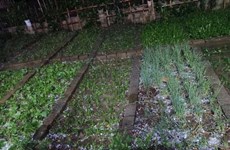Mekong floods expected early
The annual flooding in the Mekong Delta could occur early this year and
reach the third alarm level, the highest, according to the Southern
Centre for Hydro-Meteorological Forecasting.
The annual flooding in the Mekong Delta could occur early this year and
reach the third alarm level, the highest, according to the Southern
Centre for Hydro-Meteorological Forecasting.
Since last week water has been flowing into the upstream areas of the Tien and Hau Rivers , two major tributaries of the Mekong .
The Tien's water level is increasing by 2-5cm a day at the Tan Chau Station.
The floods normally begin in September though it came a month early last year.
Experienced farmers also warn of unusually severe flooding this year, saying they have seen signs in nature - more ants moving their nests into trees and unusually loud chirping by cicadas in winter.
In the Mekong 's upstream provinces of An Giang and Dong Thap, normally the worst affected during the flood season, farmers are busy preparing to harvest the floods' bounty.
Every year the floods also bring silt as well as fish and other aquatic creatures into paddy fields, enabling farmers to do aquaculture.
Mai Thanh Son, deputy chairman of the Long Thang commune People's Committee in Dong Thap's Lai Vung district, said people making handicrafts such as bamboo traps to catch fish had greatly increased production in anticipation of severe flooding.
Villages are estimated to produce 30,000-40,000 such traps this year, he said.
In a boat making village in Long Hau Commune in the same district, production has begun. Nam Hong, who has been making small boats for 20 years, said he has readied enough wood to make 250 vessels, 50 more than last year.
But since the price of wood has gone up, many boat makers are hesitant to increase production, he said.
This year Dong Thap authorities have decided to open dykes to let floodwaters wash into paddy fields to allow more silt into the fields, wash away chemicals and other pollutants, and kill pests so that the next rice crop will yield a better harvest.
Nguyen Van Hai, a spokesperson for the Dong Thap People's Committee, said the province has invested 150 billion VND (7.1million USD) to streng-then dykes in downstream districts.
In these places, the dykes will not be opened and farmers will be allowed to plant a third rice crop here, he said.
In An Giang, in areas where farmers have planted a third crop for the last three years, authorities will open the dykes to let the floodwaters in.-VNA
Since last week water has been flowing into the upstream areas of the Tien and Hau Rivers , two major tributaries of the Mekong .
The Tien's water level is increasing by 2-5cm a day at the Tan Chau Station.
The floods normally begin in September though it came a month early last year.
Experienced farmers also warn of unusually severe flooding this year, saying they have seen signs in nature - more ants moving their nests into trees and unusually loud chirping by cicadas in winter.
In the Mekong 's upstream provinces of An Giang and Dong Thap, normally the worst affected during the flood season, farmers are busy preparing to harvest the floods' bounty.
Every year the floods also bring silt as well as fish and other aquatic creatures into paddy fields, enabling farmers to do aquaculture.
Mai Thanh Son, deputy chairman of the Long Thang commune People's Committee in Dong Thap's Lai Vung district, said people making handicrafts such as bamboo traps to catch fish had greatly increased production in anticipation of severe flooding.
Villages are estimated to produce 30,000-40,000 such traps this year, he said.
In a boat making village in Long Hau Commune in the same district, production has begun. Nam Hong, who has been making small boats for 20 years, said he has readied enough wood to make 250 vessels, 50 more than last year.
But since the price of wood has gone up, many boat makers are hesitant to increase production, he said.
This year Dong Thap authorities have decided to open dykes to let floodwaters wash into paddy fields to allow more silt into the fields, wash away chemicals and other pollutants, and kill pests so that the next rice crop will yield a better harvest.
Nguyen Van Hai, a spokesperson for the Dong Thap People's Committee, said the province has invested 150 billion VND (7.1million USD) to streng-then dykes in downstream districts.
In these places, the dykes will not be opened and farmers will be allowed to plant a third rice crop here, he said.
In An Giang, in areas where farmers have planted a third crop for the last three years, authorities will open the dykes to let the floodwaters in.-VNA













